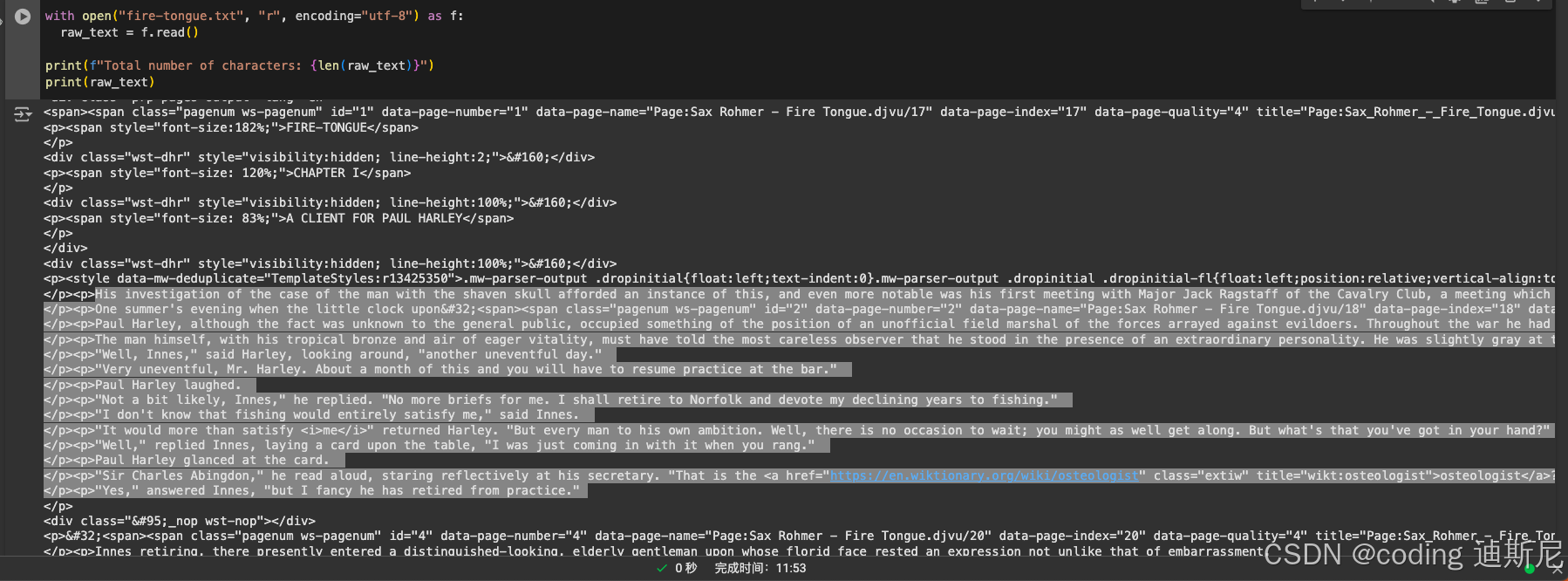大语言模型(LLM)的主要任务是:给定输入文本,它应该能够正确预测下一个单词。例如,给定句子 “llm is used to generate text”,LLM 的输入和输出如下:
llm -> is
llm is -> used
llm is used -> generate
llm is used generate -> text
可以看出,这类似于使用滑动窗口将输入文本包含其中,期望的输出是窗口右边界之外的下一个单词。需要注意的是,在此之前,我们需要对文本进行分词(tokenize),也就是说,LLM 将接收到一个数字数组,并尝试预测下一个数字。
让我们通过代码实现滑动窗口策略。在上一节中,我们通过给定的 URL 下载了训练文本,结果是一个网页的 HTML 代码。我们需要跳过返回文本的很大一部分,直到找到我们需要用作训练文本的主要内容。如下图所示,我们需要跳过开头的一部分文本,才能到达主要内容:

然后使用以下代码,我们从选定文本中提取内容,并将其转换为 tokens:
import tiktoken
tokenizer = tiktoken.get_encoding('gpt2')
with open("fire-tongue.txt", "r", encoding="utf-8") as f:
raw_text = f.read()
pos = raw_text.index("His investigation of the case of the man")
training_text = raw_text[pos:]
encoded_text = tokenizer.encode(training_text)
print(len(encoded_text))
运行以上代码后,输出为 14429,表示原始文本被分词为 14429 个 token。
我们将窗口长度固定为 4,并生成输入文本和期望输出(即下一个单词)如下:
window_size = 4
# 窗口大小决定了有多少个 token 作为输入
x = encoded_text[:window_size]
# 右移一位以获得预测单词
y = encoded_text[1 : window_size+1]
print(f"x: {x}")
print(f"y: {y}")
for i in range(1, window_size + 1):
input = encoded_text[:i]
expect = encoded_text[i]
print(input, "----->", expect)
for i in range(1, window_size + 1):
input = encoded_text[:i]
expect = encoded_text[i]
print(tokenizer.decode(input), "----->" ,tokenizer.decode([expect]))
运行以上代码,我们得到以下输出:
x: [6653, 3645, 286, 262]
y: [3645, 286, 262, 1339]
[6653] -----> 3645
[6653, 3645] -----> 286
[6653, 3645, 286] -----> 262
[6653, 3645, 286, 262] -----> 1339
His -----> investigation
His investigation -----> of
His investigation of -----> the
His investigation of the -----> case
如我们所见,输入的窗口长度每次增加一个,给定窗口输入的期望输出是窗口右边界外的下一个单词。手动完成上述所有工作显然不现实,我们可以将任务交给现有的库,从而节省时间和精力。我们将使用的库是 torch,其 Dataset 和 DataLoader 可以帮助简化输入和输出的创建过程:
import torch
from torch.utils.data import Dataset, DataLoader
class GPTDatasetV1(Dataset):
def __init__(self, input_text, tokenizer, window_size, shift):
self.input_ids = []
self.target_ids = []
token_ids = tokenizer.encode(input_text)
for i in range(0, len(token_ids) - window_size, shift):
# 按 shift 的值向右移动窗口
input_chunk = token_ids[i : i + window_size]
target_chunk = token_ids[i+1 : i + window_size + 1]
# tensor 本质上是一个向量
self.input_ids.append(torch.tensor(input_chunk))
self.target_ids.append(torch.tensor(target_chunk))
def __len__(self):
# 使 len() 可用于获取长度
return len(self.input_ids)
def __getitem__(self, idx):
# 使 [] 可用于像数组一样获取元素
return self.input_ids[idx], self.target_ids[idx]
def create_dataloader_v1(text, batch_size = 4, window_size = 256, shift = 128, shuffle = True, drop_last = True, num_workers = 0):
tokenizer = tiktoken.get_encoding("gpt2")
dataset = GPTDatasetV1(text, tokenizer, window_size, shift)
"""
drop_last: 是否丢弃最后一个 batch(当 batch 的样本数不足 batch_size 时)
num_workers: 用于运行 DataLoader 的线程数
"""
dataloader = DataLoader(dataset, batch_size = batch_size, shuffle = shuffle,
drop_last = drop_last, num_workers = num_workers)
return dataloader
with open("fire-tongue.txt", "r", encoding="utf-8") as f:
raw_text = f.read()
dataloader = create_dataloader_v1(raw_text, batch_size = 1, window_size = 4,
shift = 1, shuffle = False)
data_iter = iter(dataloader)
first_batch = next(data_iter)
print(first_batch)
运行以上代码,我们得到以下输出:
[tensor([[ 27, 0, 18227, 4177]]), tensor([[ 0, 18227, 4177, 56]])]
可以看出,目标 ID 是在输入 ID 的基础上右移一位。当然,每次只发送一个输入和期望输出对的效率较低。在深度学习训练中,我们通常会收集一个包含多个样本的批次(batch)并同时发送给模型训练,这可以提高训练效率。我们可以通过以下方式增加批量大小:
# shift 设置为 4 表示给定输入后,模型需要预测接下来的四个单词
dataloader = create_dataloader_v1(raw_text, batch_size = 16, window_size=4, shift=4, shuffle = False)
data_iter = iter(dataloader)
inputs, targets = next(data_iter)
print(f"inputs\n: {inputs}")
print(f"outputs:\n: {targets}")
输出如下:
inputs
: tensor([[ 27, 0, 18227, 4177],
[ 56, 11401, 27711, 29],
[ 198, 27, 6494, 1398],
[ 2625, 16366, 12, 3919],
[ 8457, 1, 42392, 2625],
[ 268, 1, 26672, 2625],
[ 75, 2213, 5320, 198],
[ 27, 2256, 29, 198],
[ 27, 28961, 34534, 316],
[ 2625, 48504, 12, 23],
[ 5320, 198, 27, 7839],
[ 29, 13543, 12, 51],
[ 506, 518, 14, 14126],
[ 352, 532, 11145, 271],
[ 1668, 11, 262, 1479],
[ 2691, 5888, 3556, 7839]])
outputs:
: tensor([[ 0, 18227, 4177, 56],
[11401, 27711, 29, 198],
[ 27, 6494, 1398, 2625],
[16366, 12, 3919, 8457],
[ 1, 42392, 2625, 268],
[ 1, 26672, 2625, 75],
[ 2213, 5320, 198, 27],
[ 2256, 29, 198, 27],
[28961, 34534, 316, 2625],
[48504, 12, 23, 5320],
[ 198, 27, 7839, 29],
[13543, 12, 51, 506],
[ 518, 14, 14126, 352],
[ 532, 11145, 271, 1668],
[ 11, 262, 1479, 2691],
[ 5888, 3556, 7839, 29]])























 262
262

 被折叠的 条评论
为什么被折叠?
被折叠的 条评论
为什么被折叠?








